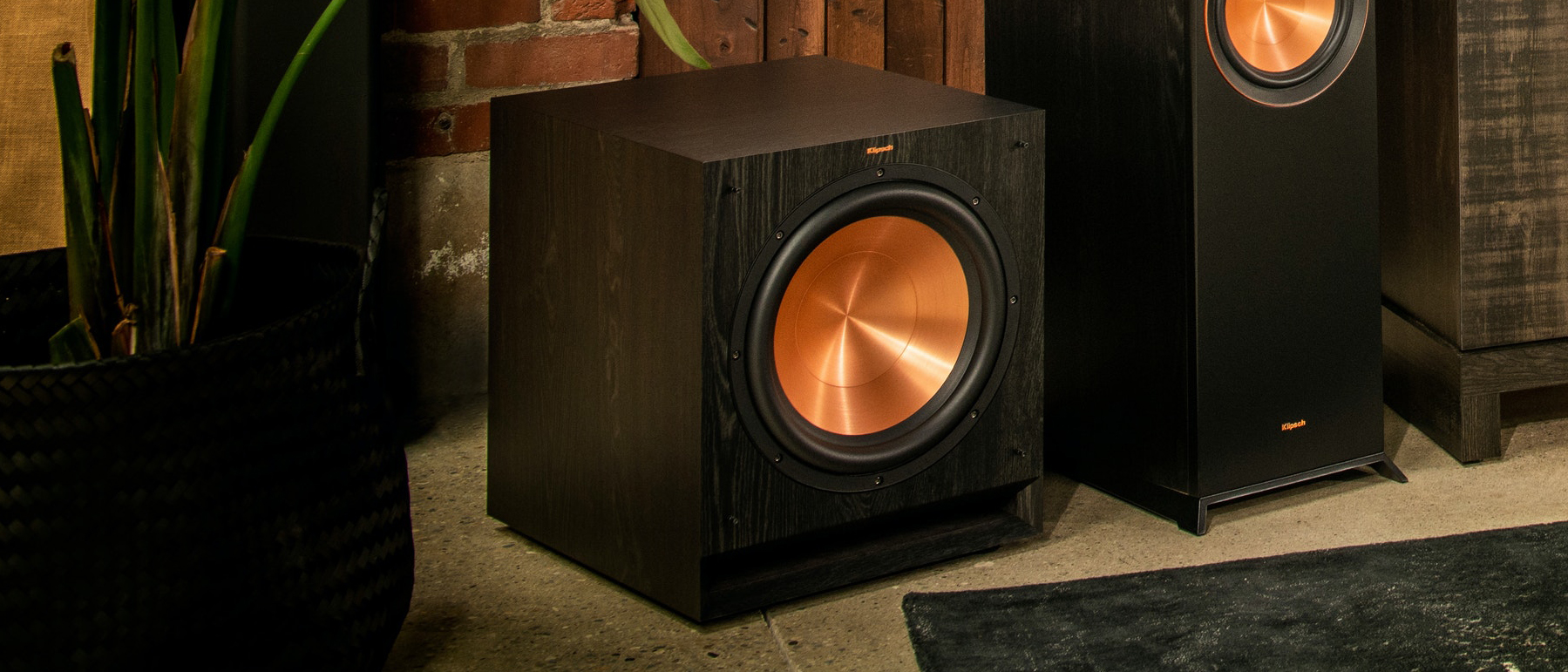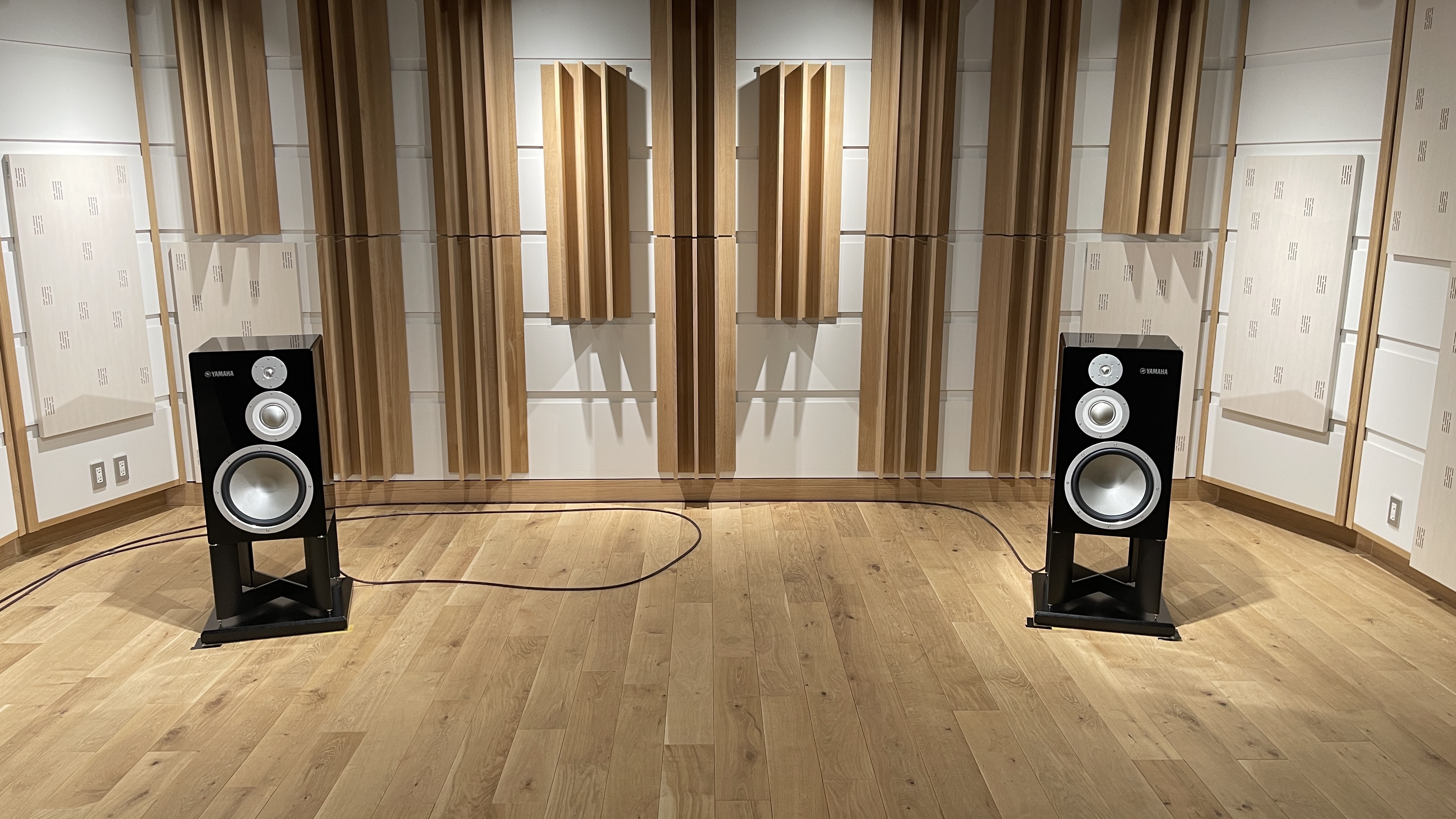What Hi-Fi? Verdict
Despite the relatively cheap vinyl finish, the gorgeous copper-coloured cone makes for a gorgeous looking unit. Its large size and strong bass projection make it ideal for larger rooms, but prohibit it from smaller areas.
Pros
- +
Effortlessly deep bass
- +
High SPLs
- +
Low distortion
Cons
- -
Very large
- -
Not suited for small rooms
- -
Vinyl finish is a little cheap
Why you can trust What Hi-Fi?

This review and test originally appeared in Australian Hi-Fi magazine, one of What Hi-Fi?’s sister titles from Down Under. Click here for more information about Australian Hi-Fi, including links to buy individual digital editions and details on how to subscribe.
I have become so accustomed to receiving shoe-box sized subwoofers for review (they being the flavour of the month, what with all the apartment buildings going up in Sydney) that when Klipsch’s SPL-150 arrived on my doorstep, I had one of those Crocodile Dundee moments, you know, that one where he mocks a New York mugger: “You call that a knife? This is a knife!”
I had exactly the same feeling once I’d unpacked it and discovered that gigantic copper-coloured bass driver. In a world where most subwoofers sport much smaller 254mm diameter bass drivers, or 305mm drivers, Klipsch has fitted a massive 381mm diameter bass driver to its SPL-150. That makes a difference to the amount of air the SPL-150 can move. A big difference.
Equipment
Since I have already told you that the SPL-150 is big, I won’t tantalise you any further by withholding its actual size until later in this review, as I usually do. It measures 546×495×566mm (HWD), so if you can imagine a cube that’s half a metre in every direction, you’d be just about spot-on size-wise.
Despite this size, the SPL-150 weighs only a little more than 34 kilos, so Klipsch is obviously keeping the weight down by using just a single-walled MDF cabinet. It’s also keeping costs down by using a standard black vinyl finish.
As for that copper-coloured cone I mentioned, Klipsch says it’s a “long-throw copper spun cerametallic” cone but the cone is not made from copper. “Cerametallic” is a trademark rather than a description of the material, so we asked Klipsch what it was made of.
“The cone is made by first forming the cone shape in aluminium, after which a unique patented process is then used to ‘grow’ a skin of alumina on each side of the aluminium core,” is what we were told.
Our source went on to say: “The resulting laminate is less dense and less brittle than traditional ceramics, yet at the same time is significantly stiffer than both metallic and non-metallic cones… plus it has the practical advantage that its properties are not affected by humidity or moisture.”
Given that the scientific definition of a ceramic is that it be ‘non-metallic’ it would seem to me that the SPL-150’s cone would be more accurately described as being made of anodised aluminium.
Klipsch’s representative went on to tell us that “an important technical advantage of the cerametallic cone over a standard metal cone is that while metal cone drivers are superior to polypropylene and paper cones across their operating band because they operate as perfect pistons across that band, they have deleterious resonances at higher frequencies.
"Coating a metal cone with the ceramic material almost doubles the speed of sound through the cone, which in turn moves these resonances much higher in frequency, where they can be effectively ‘removed’ by the crossover network.”
Such a description would also apply to the properties of an anodised aluminium cone, but of course in a subwoofer the cone does not deliver higher frequencies, so this particular advantage doesn’t apply.
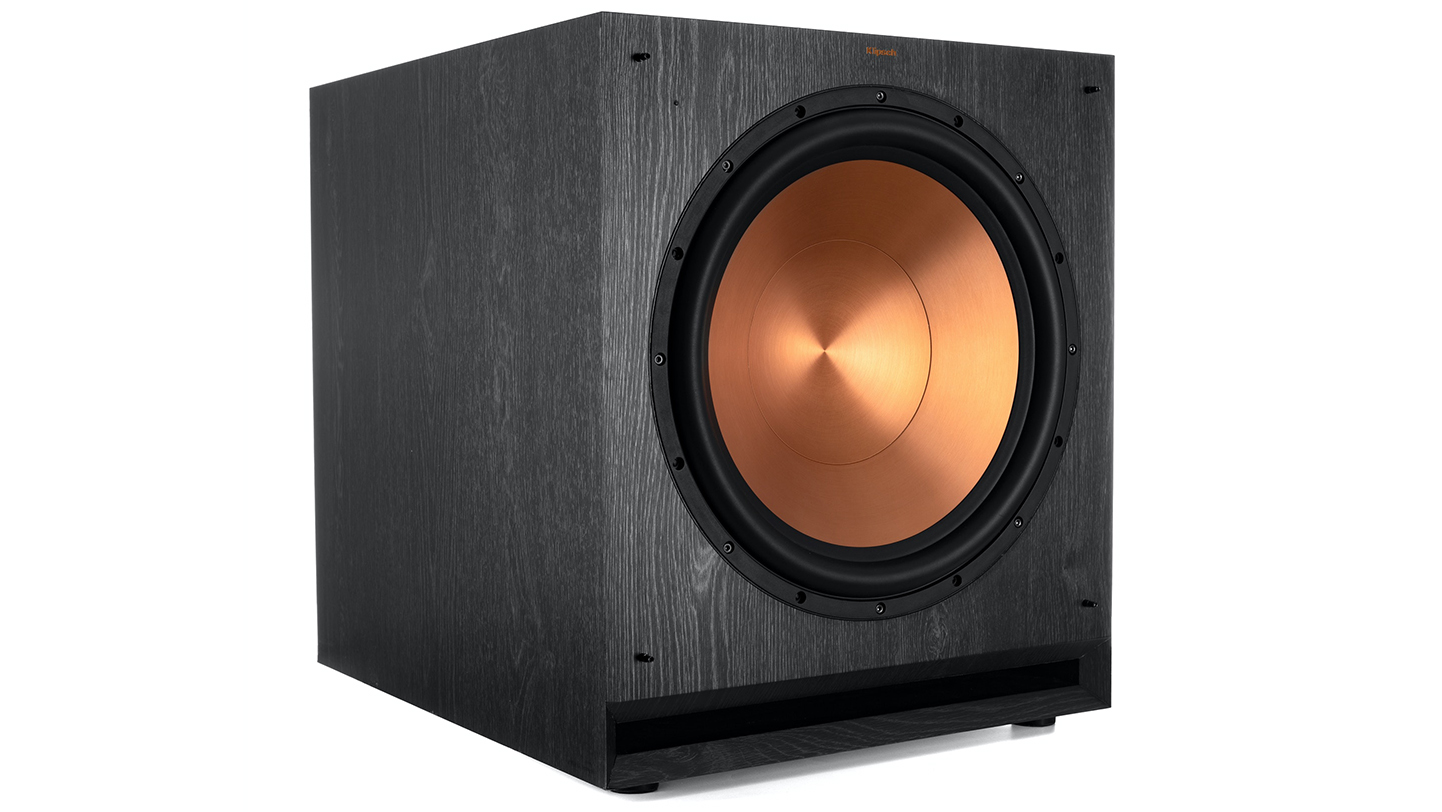
Whatever the technicalities (and the practical and technical advantages) of the process used to make the Klipsch SPL-150’s cone, and irrespective of what it’s actually made of, the process certainly results in a beautiful-looking cone with attractive coppery sheen.
Overall the driver is 381mm in diameter (15 inches in old currency), but the diameter of the cone is of course necessarily smaller, at 310mm. However the important Thiele/Small diameter which gives the effective cone area (the area available to push air) is 345mm, which gives a cone area (Sd) of 934cm².
This is not a number to be sniffed at, because even small differences in cone diameter make an enormous difference to cone area. By way of example, a typical 254mm bass driver has a cone area of only 346cm², so you’d need to use three 254mm bass drivers to get the same cone area as a single 381mm diameter bass driver.
Or, to put it another way, a single 381mm bass driver will move the same amount of air as three 254mm bass drivers (and more air than two 305mm diameter bass drivers).
The grille that can be used to cover this driver if you want (but why would you want to?) is acoustically transparent and also visually transparent as well, so you can always see the small green LED glowing underneath it whenever the subwoofer is on.
The grille does not cover the bass reflex slot at the bottom of the subwoofer, which I thought a bit odd. Maybe the appearance of the subwoofer when you’re using the grille might have been better if it had, but then again, maybe not. It’s a tough call.
I have to say that I think that Klipsch rather over-eggs its description of the design of its bass reflex slot. The description on its website says: “Klipsch SPL subwoofers leverage proprietary internal-flare geometry that minimises port noise for clean undistorted low frequencies.”
From what I could see, the port on the SPL-150 is a industry-standard slotted bass reflex design with a rectangular internal cross-section that has been bevelled at its exit. As for the cross-section of that internal rectangular section, it’s 25mm high and 440mm wide.
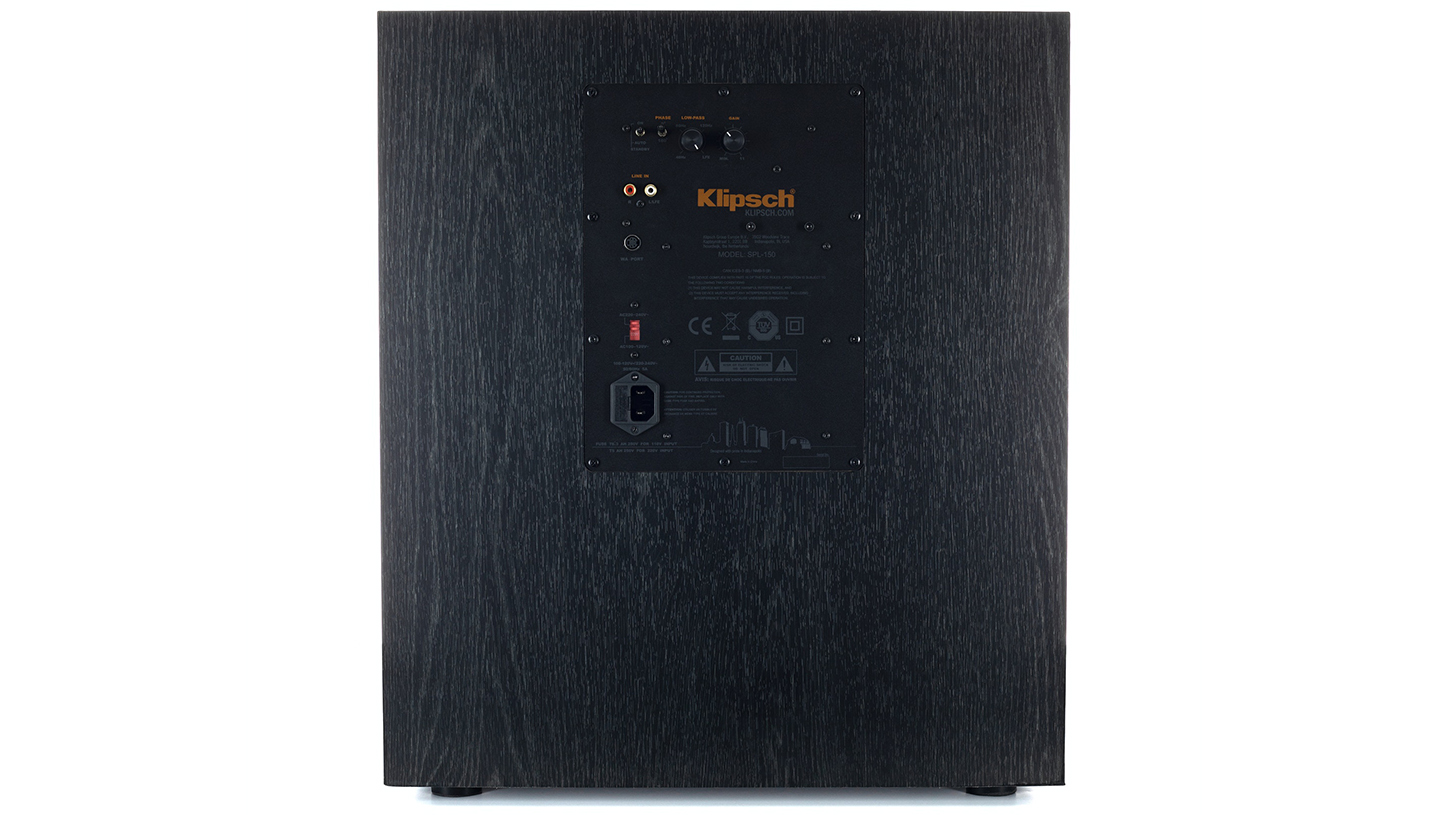
Klipsch is using a Class-D amplifier inside the SPL-150, which it rates with a continuous power output of 400-watts. Input to this amplifier is via two line-level RCA inputs, one of which doubles as an LFE input.
Signal phase can only be set for normal (0 degrees) or inverted (180 degrees) via a two-position switch. High-pass frequency is continuously variable, using a rotary switch that can be adjusted from 40Hz to 120Hz, with the most clockwise position of the control being labelled ‘LFE’ – a setting that presumably by-passes the crossover network entirely.
The volume control (marked ‘Gain’) is also rotary and has only two calibrations: Min and Max. All these calibrations are identified by grey lettering, which is extremely difficult to read against the black alloy of the amplifier plate.
Below the two RCA inputs is a multi-terminal female connector labelled ‘WA Port’. I have to confess that I had absolutely no idea what this might be for and the manual was no help at all because not only does it not have an illustration of the SPL-150’s terminal plate, it doesn’t actually even mention the SPL-150 at all, making reference only to the two smaller subwoofers in Klipsch’s range.
It wasn’t until I looked at Klipsch’s website that I discovered that the connection is a ‘Wireless Access Port’ to which you can connect an optional Bluetooth module that allows you to send LFE signals wirelessly from your system to the SPL-150.
This being the case, it seems a bit disingenuous of Klipsch to state on its website “Both the RCA and wireless inputs can be utilised, giving you the ability to use a single subwoofer with multiple system in the same room. For example, you can use the wireless input for your home theatre set up and the RCA input for your two-channel system, without needing to switch inputs when changing between systems.”
Yes, you could do this, and it’s certainly a very useful benefit, but only if you also purchase the optional WA-2 Wireless Subwoofer Kit.
Klipsch has been an American company since its beginning in 1946, when it was founded by Paul Wilbur Klipsch, but in 2005 it purchased Danish brand Jamo, and the following year Canadian manufacturer Audio Products International (whose brands included Mirage, Energy and Athena). Then in 2011, Klipsch was itself purchased by Audiovox Corporation (a company wholly owned by Voxx International).
Although Klipsch speakers are designed and engineered in Indianapolis, and certain of its models are made in the USA, notably the Heritage models, most are now manufactured in China, including this SPL-150.
Listening
If you have experienced the bass from small subwoofers with equally small drivers, you’ll heave a sigh of relief when you hear the bass issuing from the Klipsch SPL-150. Whereas the bass from small subwoofers sounds forced, the bass from the SPL-150 is absolutely effortless. There’s a smoothness and grace to the bass delivery that makes it the aural equivalent of slipping on a comfy pair of slippers.
More importantly, smaller subwoofers just do not deliver the depthy bass that you’ll hear when you audition the Klipsch SPL-150. The low-frequency response of smaller subwoofers, most especially those with smaller drivers – even if they have several of them – inevitably starts rolling off below 30Hz or so. The Klipsch just keeps powering down to at least 15Hz according to my listening sessions. That means you’ll get an octave more extension from the SPL-150, which is significant.
Sure, there’s not a lot of music down below 30Hz, due to the simple fact that very, very few instruments can play this low. For example, the lowest note that can be played on a four-string double bass is E1, which is around 41Hz. The lowest note that can be played on a five-string bass, is either C1 (≈33Hz), or sometimes B0 (≈31Hz), depending on how it’s tuned.
Of course there are some stringed instruments that play lower, one famous example being the octobass, whose lowest playable note is A1 (≈27.5Hz). However, there are very few of these in existence, due to their size (3.6 metres high), their cost (don’t ask!) and the fact that they are very, very difficult to play, because you can’t reach the fingerboard and play the strings simultaneously – there’s instead two sets of levers operated by the octobassist’s hands and feet that push the strings down to create notes. You can see (and hear!) one in action here: www.tinyurl.com/AHFoctobass
As for more conventional instruments, the lowest note that can be played on a standard 88-key piano is A1 (27.5Hz), though some grand pianos go lower, such as the Beleura, made here in Tasmania by Australian piano manufacturer Stuart & Sons. It was the world’s first nine octave piano – a 3.0 metre 108-key piano whose lowest note is C0 (16.35Hz) and whose highest is B8 (7.9kHz). Its range is almost two octaves more than a standard 88-key piano.
But even though there are few fundamental musical notes down low, there are resonances and there are acoustics, so when music is recorded live, the ‘sound’ of the venue in which the music was recorded is largely determined by the presence of low frequencies.
When a system is capable of low-frequency reproduction, you actually ‘hear’ the venue itself, as well as the music, and the less the low-frequency extension, the less you hear the venue (though you’d still be able to hear the music).
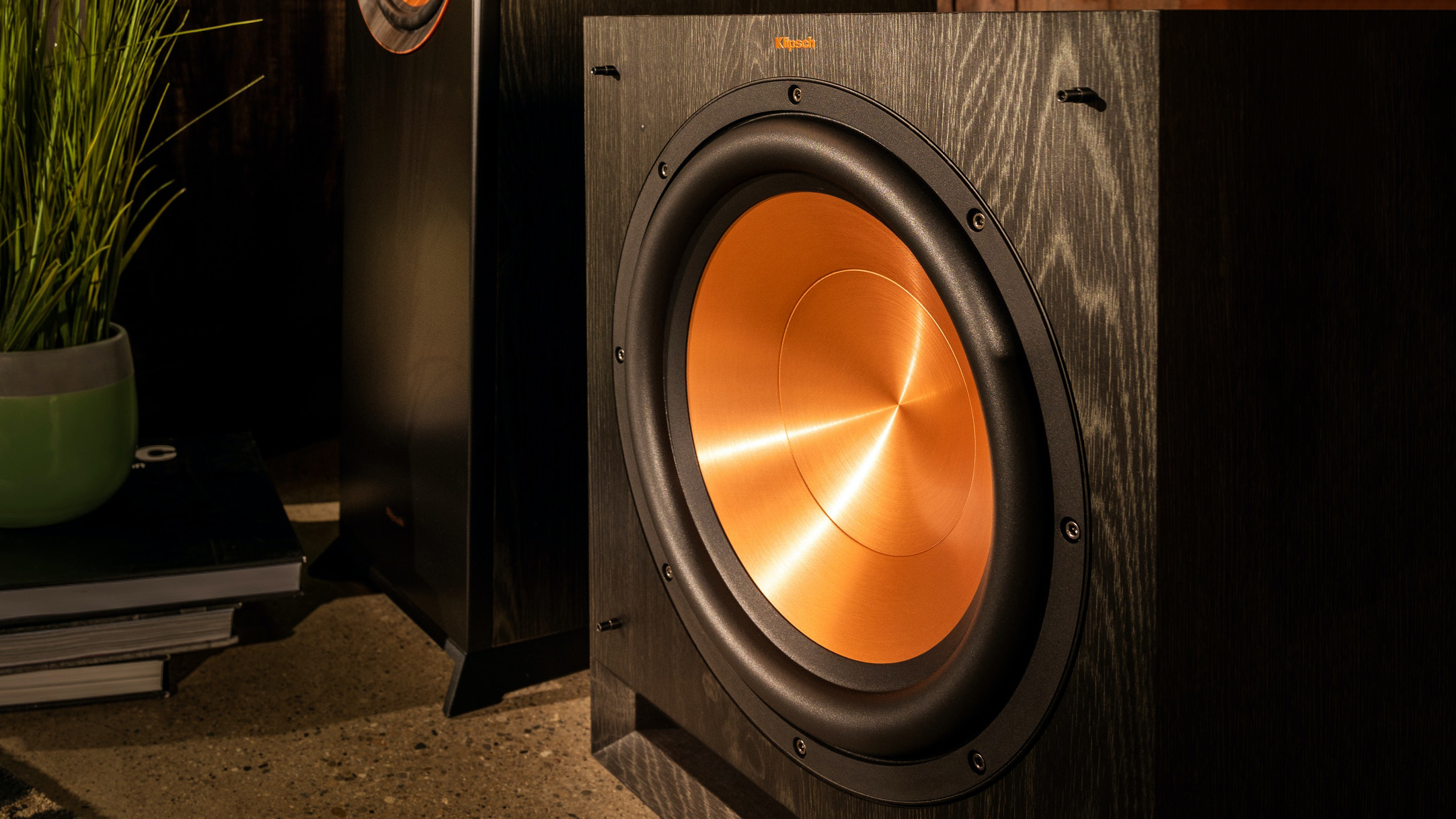
I started with the Klipsch SPL-150s underpinning the bass of a pair of large floor-standers, with the crossover control wound back to the minimum 40Hz and the increase in extension was immediately noticeable, despite the floor-standers already having excellent bass extension of their own.
The Klipsch SPL-150 not only added depth and solidity to the upper bass, it boosted the low bass that was being rolled off by the floor-standers, and added sub-bass that they weren’t reproducing at all. The overall effect was revelatory.
Listening to Jean Guillou play Bach’s famous Toccata & Fugue in D minor (Dorian DOR90134) it was one of the very few times I’ve truly heard a recording of the St Eustache Organ in Paris sound like it did when I was in Paris actually listening to it.
It may be an over-played work, but at least you can usually be guaranteed to hear performances of it when you’re on holiday in Europe. Not that I’ll be doing that in the near future, thanks to Covid-19.
It wasn’t just the thunder of the organ pipes either, nor the way the SPL-150 reached down into the bass, it was that I could hear the acoustic of the church, the reverberation as notes that had been sent to the far corners of the nave bounced off and returned to increase the complexity of the nearer sound-field. It was also the ‘fullness’ of the sound of the larger, longer pipes. I heard a richness and depth to the sound that I just don’t hear with small subwoofers.
Paired with smaller pair of two-way stand-mount loudspeakers, with the crossover set at 120Hz, the deepest bass from the SPL-150 was still totally satisfying, but I thought the upper bass from the Klipsch didn’t have quite the sonic agility of the bass from the stand-mounts, with the result that it wasn’t quite a perfect match, so I switched these out for another pair of stand-mounts with larger bass drivers, wound the crossover back a little and tried again. This time, I was more than happy with the overall sound, which became seamless.
I guess that if you have a really small pair of two-ways, you’d probably be happier with Klipsch’s smaller SPL-120 or SPL-100 models, with their smaller and more agile (but still large!) bass drivers – at least you will if you mainly use your system for listening to music.
On the other hand, if you mainly use your system for watching movies, either with three front channels, or with a complete 5.1-channel (or more) system, your choice of subwoofers will not be quite so clear-cut, because the Klipsch SPL-150 does such a fantastic job reproducing low-frequency sound effects that I really didn’t notice any kinks higher up.
Watching the depth charge attack scene in the movie U-571 (whose cast includes not only Matthew McConaughey, Bill Paxton and Harvey Keitel but also Jon Bon Jovi!), it’s not just the depth of the low frequencies the SPL-150 delivered, but also the unbelievably high forces in the listening room it was able to generate. I could literally feel the air in the room being pressurised by the depth charge explosions.
Final verdict
I just had to laugh at Klipsch’s promotional tag line for the SPL-150. It says “Large and in charge, the SPL-150 fills even the largest spaces with explosive, deep bass. We’ve been pissing off your neighbours since 1946 – why stop now?”
I laughed because yep, if you want to annoy your neighbours, deep bass is a great way to do it, particularly at any time after midnight, and you’ll not be experiencing any shortage of deep bass when it comes to the SPL-150.
In fact I can just hear the engineers at Klipsch muttering to themselves while they designed the SPL-150: “You call that a subwoofer? This is a subwoofer!”
Lab test results
Newport Test Labs first measured the frequency response of the Klipsch SPL-150 using a near-field technique that removes room-related effects, effectively obtaining the same response that would be measured in an anechoic chamber.
This technique requires that the output of the bass driver be measured separately from that of the bass-reflex port, which is the reason for the two traces shown on Graph 1.
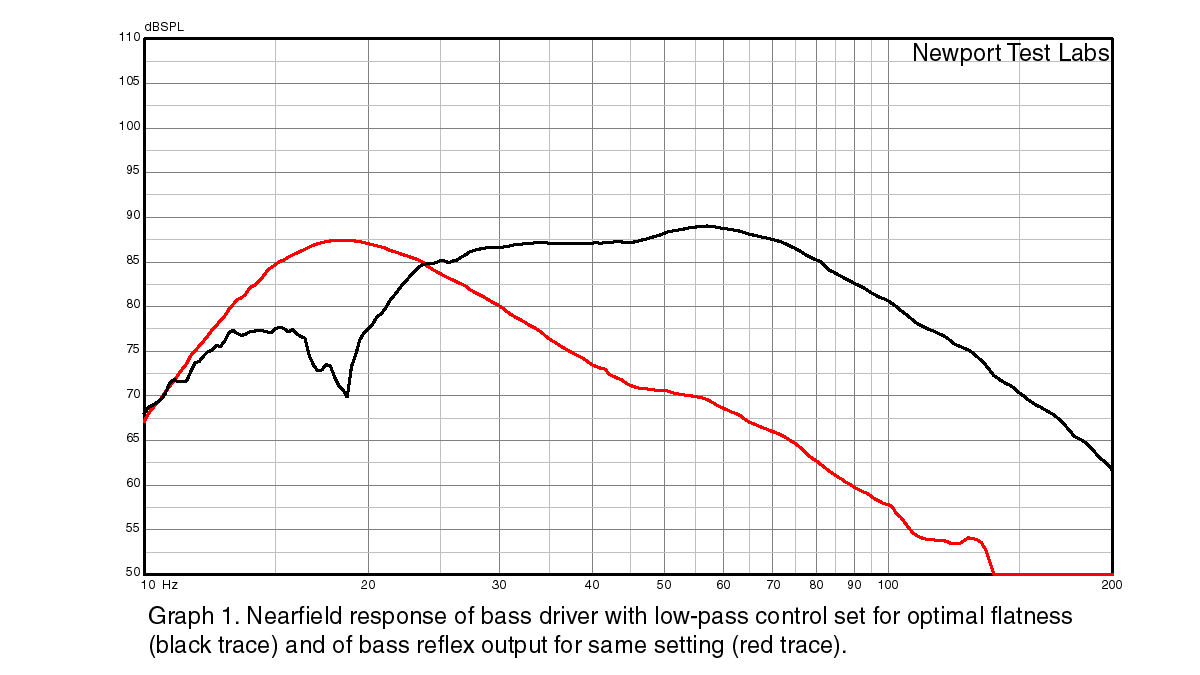
The black trace on Graph 1 shows the frequency response of the SPL-150’s bass driver when the crossover control is set to approximately ‘half past 10’, which the lab reported was the setting that gave the ‘flattest’ response when conducting this test. You can see that the response is within ±3dB from around 23Hz up to 90Hz, which is an excellent result.
The red trace shows the output of the front-firing bass reflex port and you can see that it peaks at around 18–19Hz and rolls off very smoothly either side, so that its output could be characterised as 14–28Hz ±3dB.
Klipsch’s engineers have done a very good job on this, because you can see that the output of the bass reflex port starts rolling off above 20Hz and the output of the bass driver starts rolling off below 30Hz, with the two traces crossing approximately midway.
This means that the outputs of the two would sum complementarily across this bandwidth such that the overall combined response would be approximately 14Hz to 90Hz ±3dB.
(I note that Klipsch claims 18Hz to 125Hz, but since it doesn’t mention the dB level variation across this range, I can’t speculate on any differences between Newport Test Labs’ measured results and Klipsch’s specifications).
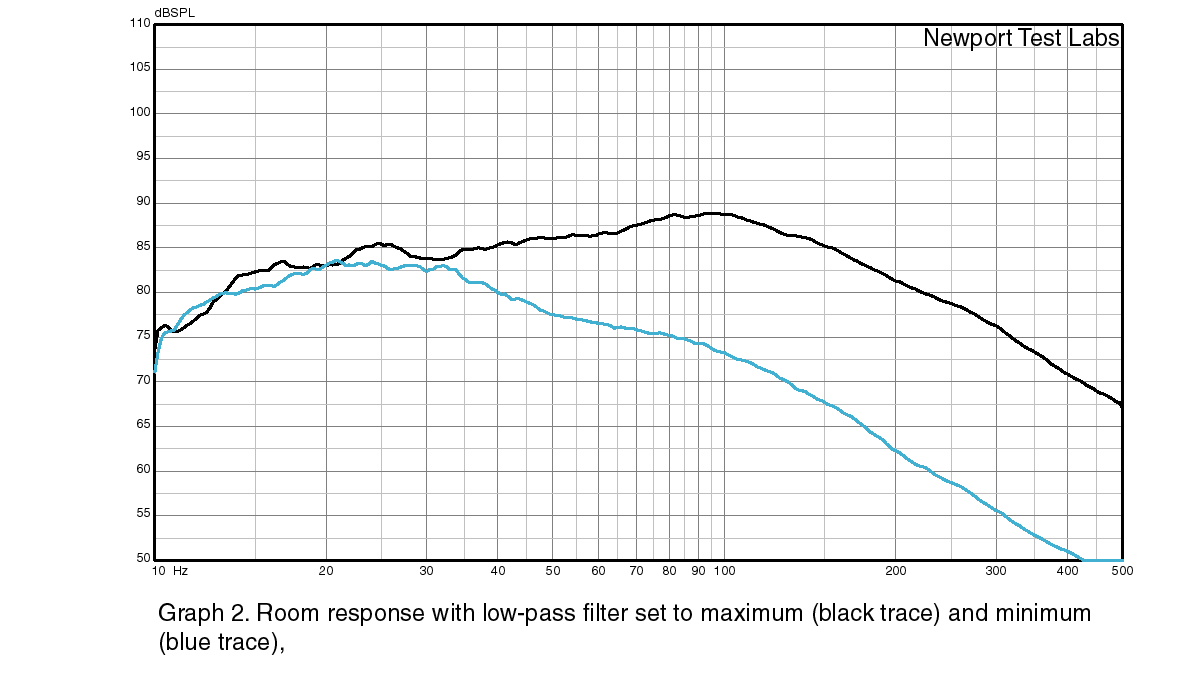
Graph 2 shows the room response of the Klipsch SPL-150, measured at a distance of three metres using pink noise. This time, the black trace shows the frequency response of the SPL-150 when the crossover is set to maximum and the blue trace shows the response when it’s set to its minimum.
You can see that set to minimum, the response extends from around 13Hz to 50Hz ±3dB. The maximum setting shows a frequency response of 16Hz to 180Hz±3dB, but at the expense of a bit of a peak in the response centred at around 90–100Hz.
Backing off on the crossover a bit would flatten this response out, but would also truncate the extension somewhat, so it would be closer to Klipsch’s specification, leading me to guess that the company is probably stating a room response with a ±3dB window for its published spec.
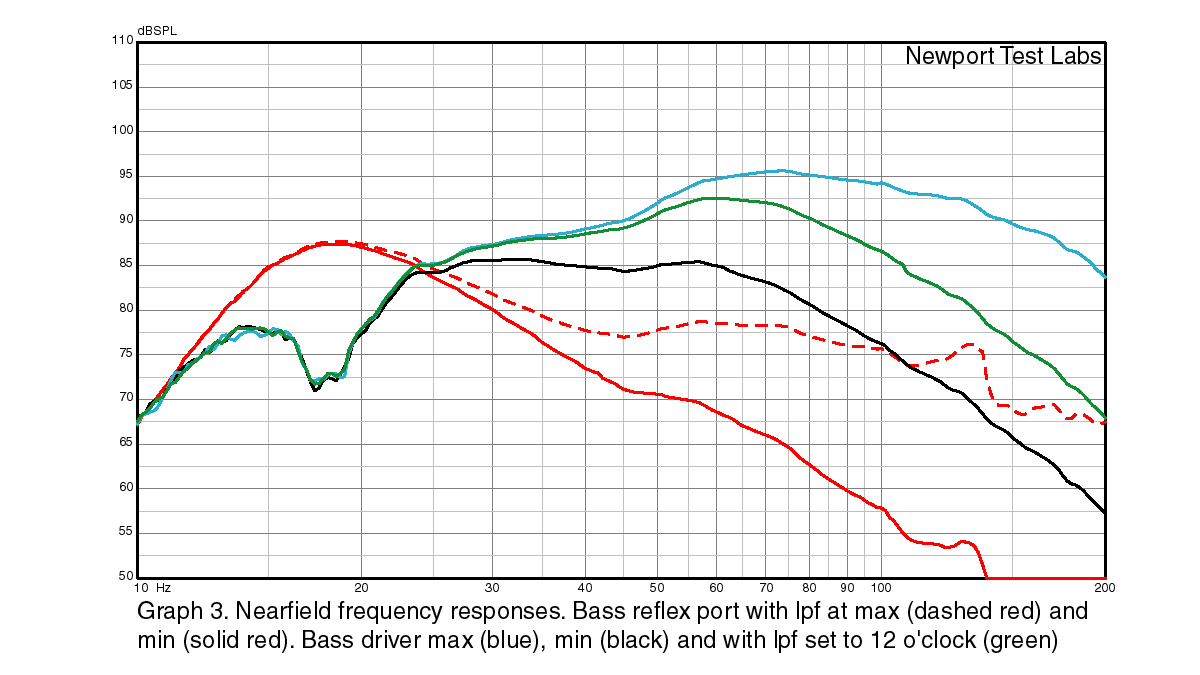
Graph 3 shows the set of near-field responses for the Klipsch SPL-150 that Newport Test Labs measured for various settings of the crossover control. You can see that the port’s output is very well-behaved at both minimum (solid red trace) and maximum (dashed red trace) of the crossover, though as you’d expect, there’s more high-frequency leakage from the port at the maximum setting.
The black trace on Graph 3 shows the frequency response of the driver when the crossover is set to 40Hz (minimum); the blue trace shows the response when the crossover is set to LFE, and the green trace shows the response when the crossover is set to the ‘12 o’clock’ position.
These traces suggest to me that maybe Klipsch should have labelled the minimum setting on its crossover control as being 60Hz.Newport Test Labs was not able to test the maximum sound pressure levels of which the SPL-150 might be capable (Klipsch claims a 122dBSPL) but it did confirm that this subwoofer is capable of delivering levels in excess of 110dBSPL at 40Hz without audible distortion, which will be far more than is required for any domestic application.
Overall, Newport Test Labs’ measurements of the Klipsch SPL-150 show that it’s capable of delivering seriously deep bass at seriously high sound pressure levels
Australian Hi-Fi is one of What Hi-Fi?’s sister titles from Down Under and Australia’s longest-running and most successful hi-fi magazines, having been in continuous publication since 1969. Now edited by What Hi-Fi?'s Becky Roberts, every issue is packed with authoritative reviews of hi-fi equipment ranging from portables to state-of-the-art audiophile systems (and everything in between), information on new product launches, and ‘how-to’ articles to help you get the best quality sound for your home. Click here for more information about Australian Hi-Fi, including links to buy individual digital editions and details on how best to subscribe.
